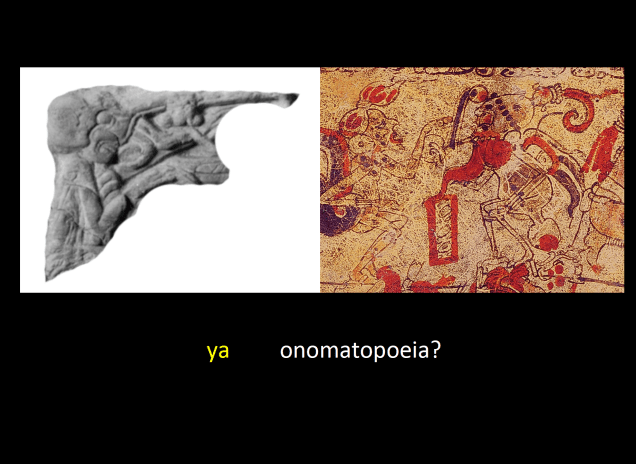by Stephen Houston (Brown University)
The sound comes before the sighting: that high-pitched, oscillating whine mosquitoes make as they hover nearby. [1] The naturalist E. O. Wilson (1984) claims that humans are predisposed to “biophilia,” a pleasing sense of affiliation with the lush, evolutionary miracle that surrounds us. With these creatures, biophilia surely gives way to different reactions—rage, a desire to destroy, yes, E. O. Wilson, even “bioanimus”: “where is that pest, when will it bite, can I kill it before it does?”
Few would dispute that the mosquito makes a most maddening noise, foretelling pain, itching, vexation, disease. Captain Haddock, beloved curmudgeon of the Tintin books, could not agree more—note the artist, Hergé (Georges Remi), and his idea of what these critters sound like, later proved to be the clamor of a descending helicopter (Fig. 1).

Figure 1. What mosquitoes sound like (Hergé 1960:29).
Sounds of animals are, in most languages, understood in terms of echoic mimicry, a perception, influenced by varying motivations, of what noise is seemingly heard from this or that animal: bow-wow for speakers of English, vov-vov in Swedish, the language of my youth. Perhaps, according to some researchers, the size of an animal makes a difference too, high tones associating with smaller creatures, such as birds (tweet-tweet), low tones and back vowels with bigger, lumbering beasts like cows (moo; Bredin 1996:567; see also an early formulation by Jespersen 1922:402).
The Maya region does not lack for mosquitoes. Some are small, others equipped with white-tipped legs or they may shimmer with blue iridescence—their bites can be dainty, often unnoticed pricks, or, in larger ones, they may feel like painful drillings. Long ago, Karl Taube pointed out to me how striking, even beautiful, mosquitoes can be when depicted in Maya vase painting (Fig. 2; see also K1223, K2759). Rich in plumage, with dark wings (that marking was first studied in other creatures by Marc Zender), they excreted blood, and, in a curious feature, showed long proboscides perforating a single flower.
This last doubtless accorded with close observation of nature, but not too close, for it is based on gender confusion. The males nourish themselves with juices or nectars, while the females require blood to sustain their eggs. These respective attributes were not, it seems, minutely understood by the Maya. An overriding feature is the emphasis on the skeletal, even exoskeletal, nature of such insects, along with an extra eye on the forehead, and, at times, leaking or smoking protuberances at their bottoms. An example from the Princeton University Art Museum, pointed out by Bryan Just, combines a mosquito with the features of a bird (PUAM 2003-291, MS2089), probably a gloss on a shared capacity for flight. But, for the mosquitoes, the key component is a set of two volutes, identified some time ago by David Stuart as blood scrolls. Evidently, the mosquitoes were sloppy eaters, and the excess spilled messily from their jaws.

Figure 2. Dazzling mosquito feeding repeatedly on a cormorant(?)—an image of sustained agony (K2668, photograph by Justin Kerr, used with permission).
Such noxious creatures are not unique in Maya imagery. There may also be depictions of ticks or lice with hook-like talons, bloody mouths, and a disturbing profusion of eyes, perhaps a comment on the complex visual apparatus of insects (Fig. 3). In Maya imagery, these afflict a bloated mammal, an association pointed out to me some years ago by Karl Taube, but comparison with another vase demonstrates a seemingly free alternation with mosquitoes, K1223; see also Chinchilla Mazariegos 2017:12–15, who suggests that the mammal combines jaguar and tapir). In both cases Chahk, the Storm God, poises to strike these bloodsuckers. With axe in hand, he takes ferocious aim at them.

Figure 3. Possible ticks or lice (K555, photograph by Justin Kerr, used with permission).
This essay began with a reference to sound. Echoic mimicry—that deeply annoying sound of mosquitoes—may explain a variant form of the ya syllable in Maya writing (Fig. 4). It is clearly skeletal, has a long beak, and disgorges bloody volutes. What is different in this example is that the creature is supplied with wings (one thrusts horizontally to viewer’s right) and, on its proboscis, is a probable flower or gout of blood. The ya variant is likely a mosquito.

Figure 4. A mosquito in place of the syllable ya (Yaxchilan Throne 2, photograph provided by Ian Graham), compared with blood-drooling, blood dripping mosquito (K9225).
Captain Haddock may have heard BZZRRBZR, but it takes little imagination to see yayayaya (and so forth) as the perceived sound of Maya mosquitoes, segmented into a front vowel, i, gliding into a low front a and back again, along a long stream of torment foretold. Alternatively, the basis for the syllable ya was simply a term (a mimetic one too, from ya!, the sound of misery?) for “pain” or “sickness,” as in Chontal yaj (Keller and Luciano 1997:292), perhaps linked in Maya minds with the vexing bite of mosquitoes.
[1] For other entries in the “Maya Creatures” series, see Maya Musk, Dragons, Dogs.
Acknowledgements Thanks go to Karl Taube for discussing many nasty creatures over the course of our long friendship. Oswaldo Chinchilla posed a useful question about the tick/louse-infested beast, as did Bryan Just about a piece under his care at the Princeton University Art Museum.
References
Bredin, Hugh. 1996. Onomatopoeia as a Figure and a Linguistic Principle. New Literary History 27(3):559–569.
Chinchilla Mazariegos, Oswaldo. 2017. Art and Myth of the Ancient Maya. New Haven: Yale University Press.
Hergé [Georges Remi]. 1960. The Adventures of Tintin: The Calculus Affair. London: Methuen.
Jespersen, Otto. 1922. Language: Its Nature, Development, and Origin. London: George Allen and Unwin.
Keller, Kathryn C., and Plácido Luciano G. 1997. Diccionario Chontal de Tabasco. Tucson: Instituto Lingüístico de Verano.
Wilson, Edward O. 1984. Biophilia. Cambridge, MA: Harvard University Press.
One thought on “Maya Creatures III: Mosquitoes and Maddening Noise”
Comments are closed.